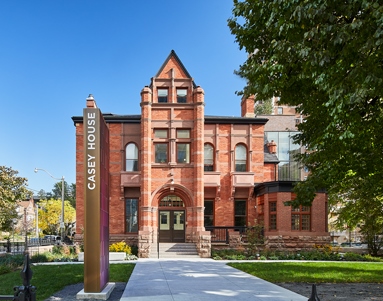Shona Thompson, RMT at Casey House
BlogImage
Shona Thompson has been an RMT at Casey House, Canada’s only standalone hospital for people with HIV/AIDs, for the past ten years. During that time, she has worked collaboratively with other health professionals to make a real difference in the lives of her patients.
Shona feels fortunate for the opportunity to be a part of the team at Casey House, and finds that it’s really the people that make it a rewarding place to work. She finds that she has been able to develop a greater understanding of the complexity of people and the way all of the factors in someone’s life can really affect their health.
“Most importantly I have learned that how a person presents is often not a true representation of what’s going on beneath the layers,” Shona said. “It is rewarding to receive people as all being equal and deserving of the same time and care that we give.”
The work of an RMT at Casey house goes beyond providing treatments. Shona enjoys the opportunity to participate in clinical rounds, and actively contributes to medical discussions and problem solving about the complex issues people face day-to-day that ultimately impact their health.
Shona shares her office space with nurses and recreational therapists, and enjoys working collaboratively with them to design programs for patients. These collaborative opportunities are one of the things Shona enjoys most about her work environment.
“I respect my co-workers. They provide tremendous support to one another which is essential in what is often times a heavy working environment,” she said.
 The majority of the population that Shona treats would not otherwise be able to afford massage therapy, and they may not have previously considered massage therapy as an option that could help them.
The majority of the population that Shona treats would not otherwise be able to afford massage therapy, and they may not have previously considered massage therapy as an option that could help them.
“Where I see what I do as an essential health benefit, most see it as a luxury, which is very unfortunate because of how beneficial massage therapy is for everyone,” Shona said.
Massage therapy can help people with HIV address physical and emotional needs, and alleviate some symptoms associated with this diagnosis. Shona has seen massage therapy help people at Casey House whether they are well-supported or isolated.
One person in particular, who has been rejected by friends and family since her diagnosis, comes for massage therapy to help her cope with her severe sense of isolation and the fear of her HIV status being disclosed to her cultural community (which has a strong prejudice against HIV). She states, “I can share, I can have somebody to talk to. I can enjoy physical and emotional help at the same time.”
When Shona tells people that she works with people that are HIV positive, she gets a lot of questions. She thinks that many questions unfortunately come from the stigma and fear that exist around HIV. Although most RMTs won’t have the experience of working at Casey House, any RMT may treat a person with HIV, so Shona emphasizes that HIV can be very isolating, and it’s important to treat people as people and not as a diagnosis.
“I would encourage all people to learn more about HIV so that they can be better healthcare providers but also so that they can be more supportive to people in their lives should anyone ever disclose to them that status,” Shona said.
To learn more about massage therapy for people with HIV, read Shona’s article The Grapple of Massage, originally published in the Fall 2016 issue of Massage Therapy Today.
Learn more about Casey House.

